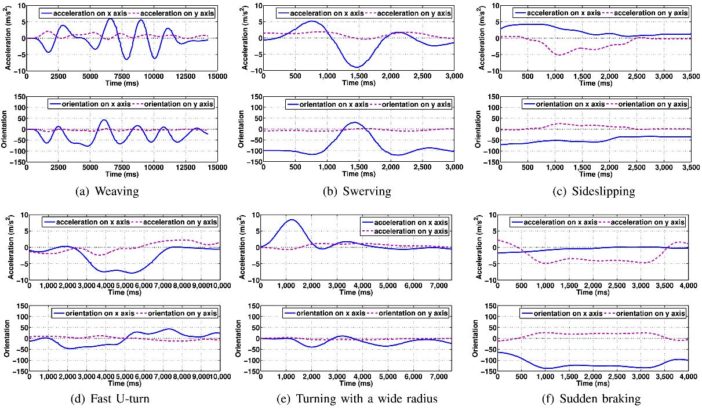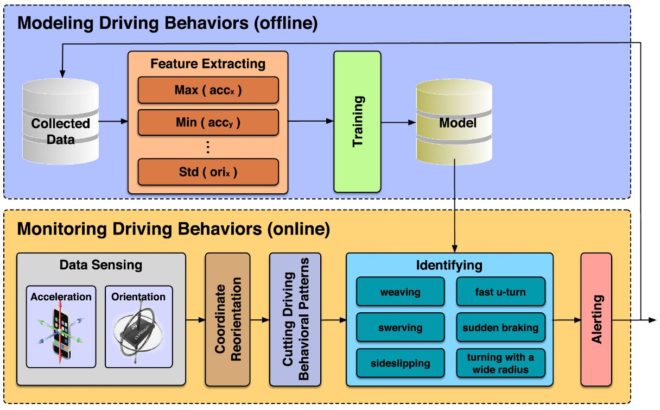When it comes to driver safety, let’s face it: smartphones do not have a good reputation. However, new research from China suggests there may be a role these devices can play to make people better drivers. By incorporating machine learning, smartphones may be able to help drivers ditch bad habits like sudden braking and swerving.
The researchers–lead by professor Jiadi Yu and Yingying Chen from Shanghai Jiao Tong University and Stevens Institute of Technology respectively–devised a machine learning-based approach using smartphones to not only detect abnormal driving, but to identify specific behaviors and alert the drivers. This differs from existing systems that monitor for abnormal driving, but don’t provide detailed information on the types of behaviors committed.
“This work is very meaningful when it comes to improving driving safety,” said Jiadi Yu, an associate professor at Shanghai Jiao Tong University. “For example, a taxi company may want to know how their drivers are performing. For these companies, it is necessary to show that their drivers have adequate driving skills. For insurance companies, this system can be useful in helping to decide the level of insurance to provide certain policy holders.”
Coined “Driving behavior Detection and iDentification” (or D3) by the research team, the system aims to identify six driving behaviors, which include weaving, swerving, side-slipping, fast U-turn, turning with a wide radius, and sudden braking. By receiving this detailed information, the intent is for drivers to be quickly informed of their poor habits and work to correct them. It works like this:

Figure 1: Acceleration and orientation patterns of the six types of abnormal driving behaviors.
For each of the six driving behaviors, there is a unique reading pattern recorded by accelerometer and orientation sensors, both of which are linked to the D3 smartphone application. This application measures various features (standard deviation, mean, time duration, etc.) used to identify specific driving behaviors committed by drivers.
Two machine learning techniques–Support Vector Machine (SVM) and Neural Networks (NN)–proved feasible to train the classifier model for distinguishing between different types of driving behaviors. Based on the classifier model, the system can quickly and reliably detect and identify abnormal driving behaviors in real scenarios under a 100 hertz sampling rate (100 times per second) of sensors.
Graphically represented in Figure 2, the D3 app uses modeling and monitoring segments that train a classifier model to detect abnormal driving behaviors.

Figure 2: D3 modeling and monitoring system architecture
Using previously collected data, D3’s modeling segment can identify specific types of driving behaviors based on unique features (standard deviation, mean, etc.) of the six behaviors. Once pulled, the features are trained into a classifier model, which are then stored in a database to be used as a comparison in the monitoring segment.
In the monitoring segment, sensors detect actions in real time, “cutting” them into three parts (beginning, middle and end). The system then compares those parts against information in the database. If a behavior is detected, the smartphone alerts the driver.
In practice, the modeling segment monitors real-time actions for abnormal driving behaviors. For example, if a candidate of abnormal driving, e.g., sudden braking, is detected, then the monitoring segment will cut the sensor data of this behavior. Using this data, D3 will then identify whether the poor driving was sudden braking or a different behavior.
So how did it perform in real life?
The researchers conducted a study on 20 drivers over four months and found a 95.36 percent accuracy rate (the ratio of correct identifications to total identifications) with the SVM classifier model and a 96.88 percent accuracy rate with the NN classifier model. The information obtained from this study will be used as a basis for comparison moving forward, allowing a user to begin using the device immediately versus needing to build a personal dataset.
Though this system could be used for a variety of purposes, the research team, along with PingJia Technology Co., Ltd., is in the process of commercializing the smartphone application for insurance companies. It will be used to provide a driving score for each driver that can connect back to insurance companies’ records. The team is expecting this application to become available in 2018.
By developing a system that can identify intricate driving details, individual drivers, insurance companies, and more can redefine what it means to be a “good” driver.
For more information on driving behaviors, visit the IEEE Xplore Digital Library.





